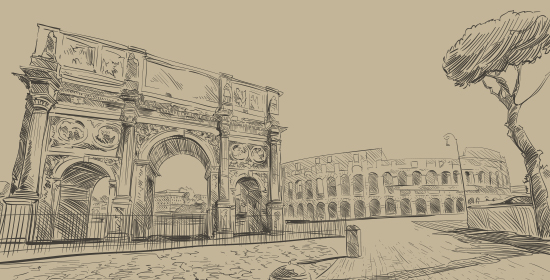Inside Villa d'Este, Tivoli: Guide to Renaissance Splendors Within
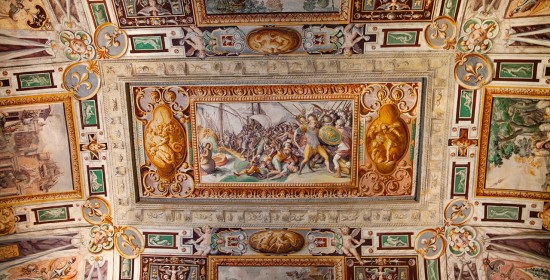
Buongiorno and welcome to RomeCabs, Rome’s top-rated Tour Company for private tours in Italy. Villa d’Este is featured along with Hadrian’s Villa on our popular Tivoli Villas Tour from Rome, and Post Cruise Tivoli Tour from Civitavecchia.
When visiting Villa d’Este, the attention often gravitates towards the enchanting Italian gardens with their captivating fountains and meticulously groomed hedges. Yet, the grand villa itself, occasionally overlooked as a mere passage to the gardens, houses opulent treasures. Inside, magnificent frescoes await, each a Renaissance masterpiece, captivating with their beauty and profound symbolic narratives.
This guide will lead you through the essential halls within Villa d'Este, providing insights for your upcoming visit. As we've dedicated this blog specifically to the details of exploring the grand villa, we'll reserve another blog to delve into the enchanting gardens and fountains of Villa d’Este.
In addition to our Tivoli Villas and Gardens Tour from Rome, RomeCabs offers additonal opportunities to visit Villa d'Este in Tivoli:
- Post Cruise Tivoli Tour from Civitavecchia
- Rome to Amalfi Coast with a visit to Tivoli (* Sightseeing Transfer)
So, let’s embark on a captivating visit to Villa d'Este, where history and elegance unfold at every turn.
Renaissance Splendors inside Villa d'Este,
Tivoli Tours from Rome
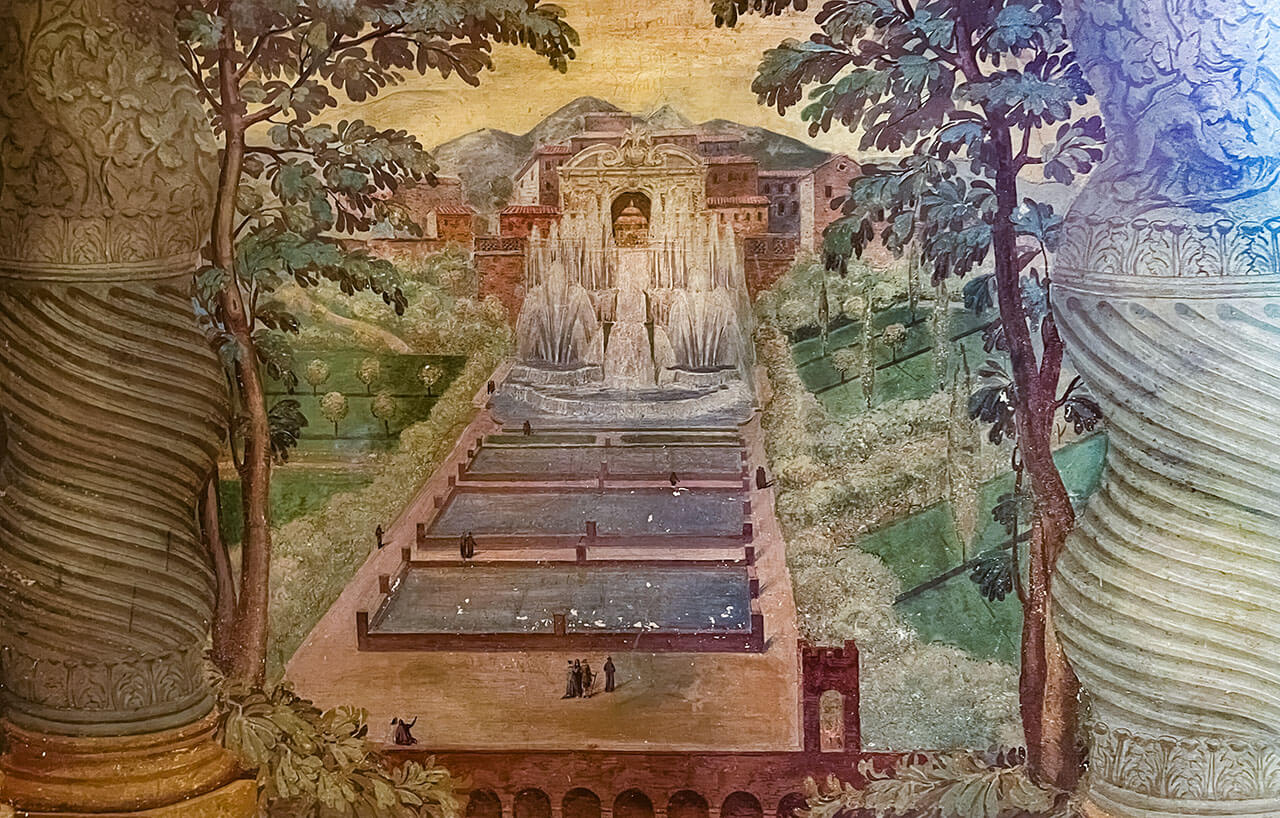
Begin your exploration from the lively Piazza Trento, right by the entrance to the Church of Santa-Maria Maggiore. Surprisingly, in the era of Ippolito d'Este, this entrance wasn't the main gateway for visitors. Instead, they approached from the garden's lower realms, ascending gradually amidst the allure of enchanting fountains and timeless statues.
The door that welcomes you today is a portal to history, dating back to 1521, well before the time of Ippolito. As you traverse the Courtyard that was once a cloister, you will see the original Fountain of Venus, a masterpiece by Raffaelo Sangallo (1568–69). Adorned with two majestic Doric columns, it is crowned by a 4th-century marble bust of the Ancient Roman Emperor Constantine.
Once inside, one of the first things you will notice is the villa’s linear enfilade design, a unique example of Renaissance architecture where rooms are arranged in a straight line. This setup provides a structured and flowing layout, with each room leading smoothly into the next. While it sacrifices some privacy, this design highlights symmetry and elegance, both important aspects during the Renaissance period.
APARTMENTS OF THE CARDINAL IPPOLITO
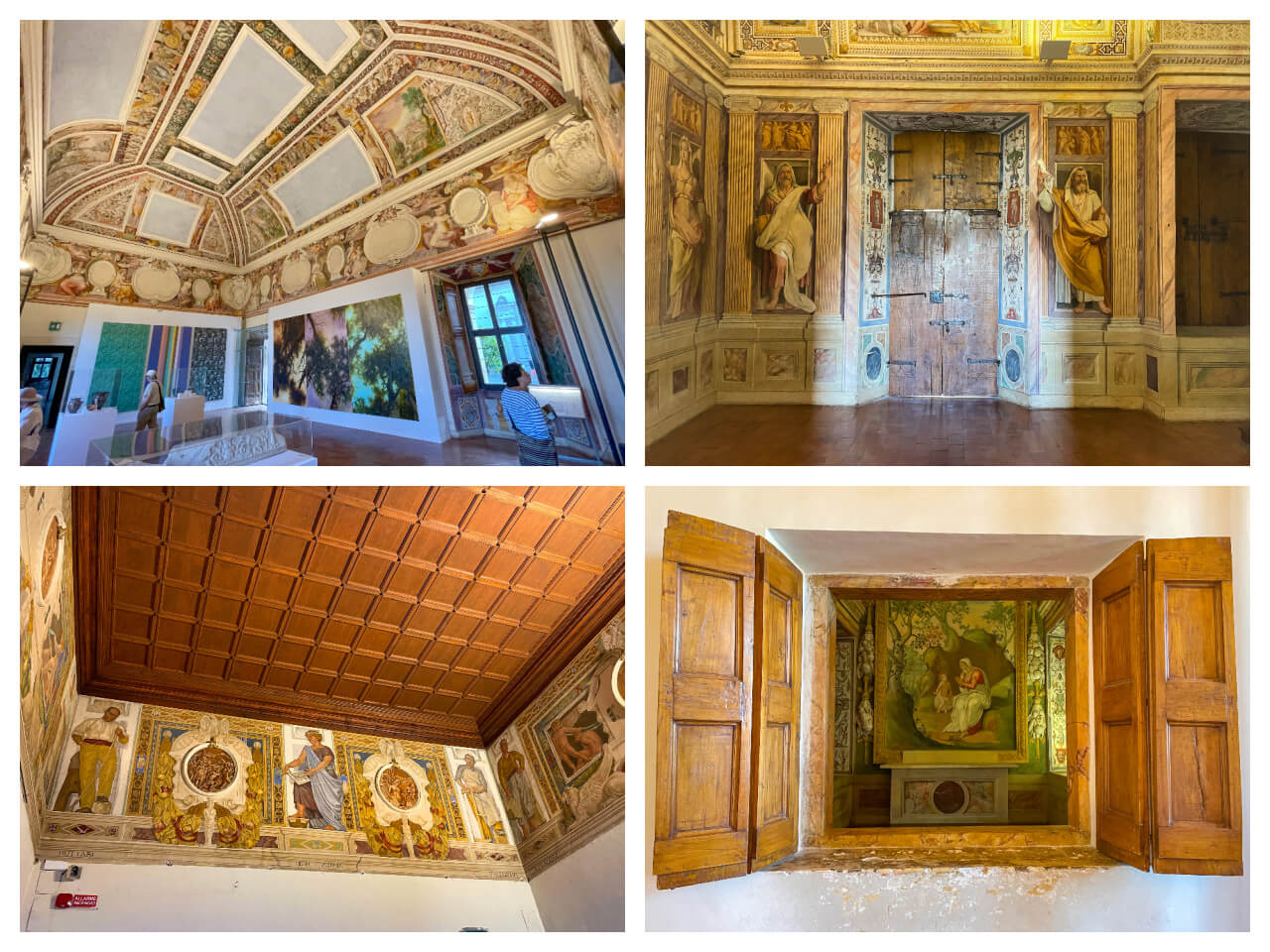
As you begin with the ground floor Salon, you will step into the exquisite Apartments of the Cardinal, a lavish sanctuary within Villa d'Este that breathes life into history. While the walls now stand bare, the ceiling vault is adorned with Livio Agresti's masterpiece of twenty virtue personifications that whisper tales of the past.
Venture into the adjacent antechamber to the Cardinal's Bedroom, a space known for its coffered wooden ceiling embellished with the Este family crest in gold. The walls, once covered with painted leather, portray feminine figures embodying various aspects of virtue.
Continue to Pirro Ligorio's Gran Loggia, a gateway to a private library and chapel. The walls of the chapel are decorated with classical Christian frescoes with a vault depicting the coronation of the Virgin Mary.
HALL OF NOAH
Painted in 1570-71 and attributed to Durante Alberti and his assistants
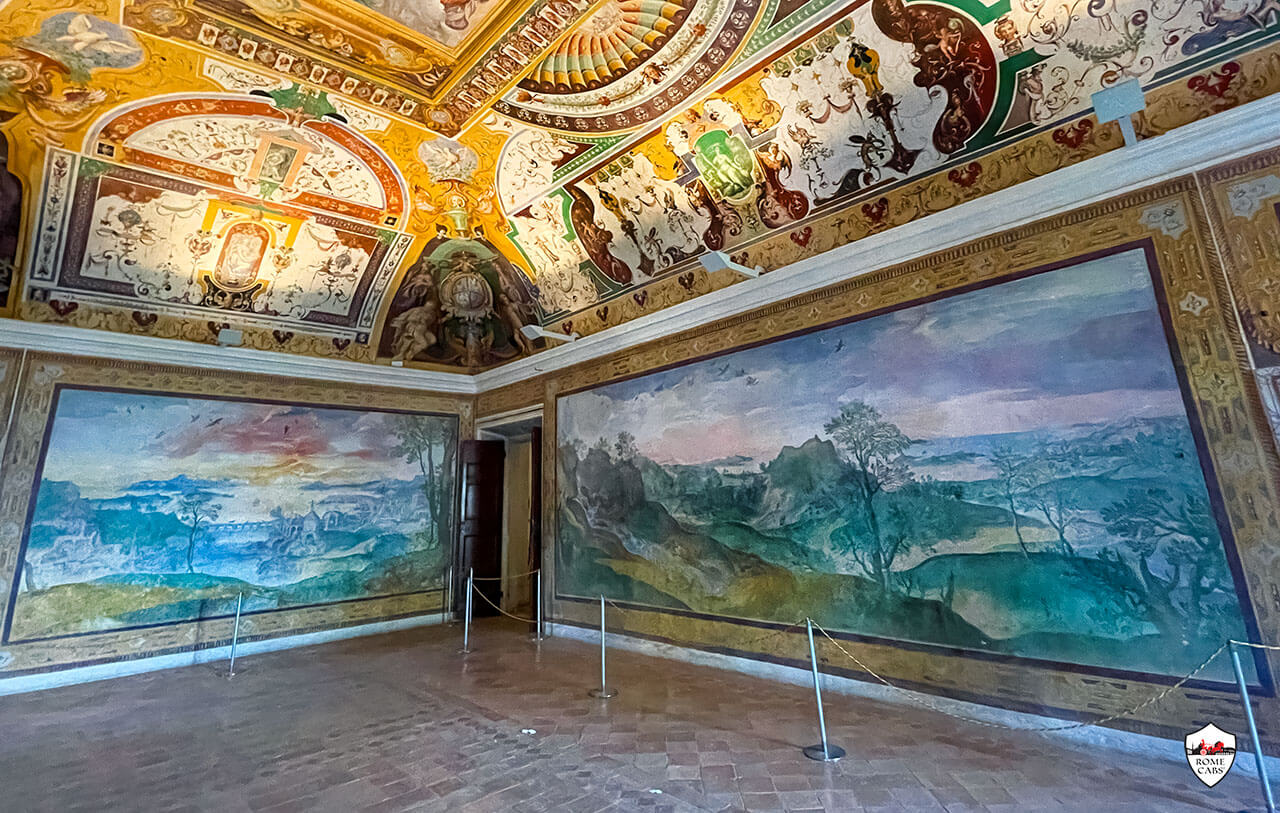
This grand Hall of Noah unfolds like a canvas, treating you to dual vistas that showcase the main garden's captivating water features on one side and the secret garden, a sanctuary of statues, fountains, and medicinal plants, on the other.
The walls are covered with frescoes that mimic ornate tapestries, intricately bordered with the iconic Este lilies. The scenes painted on these walls transport you to expansive landscapes, creating an illusion of infinite space that captures the essence of boundless beauty.
Look up, and you'll find yourself in the heart of a divine spectacle: Noah, post-flood, fervently praying to God, a prominent eagle soaring high, and the Ark perched majestically on Mount Ararat, emphasizing the might of water as a force of the divine.
In the grotesque-style vault, putti at the corners proudly showcase the cardinal's coat of arms, flanked by faux marble herms. Herms were a standard element of architecture in the classical style of tapered rectangular pillars topped with a portrait bust. Oval frames reveal depictions of the Four Seasons and allegorical figures embodying Prudence and Temperance.
HALL OF MOSES
Painted between 1570-71 by Durante Alberti and his assistants
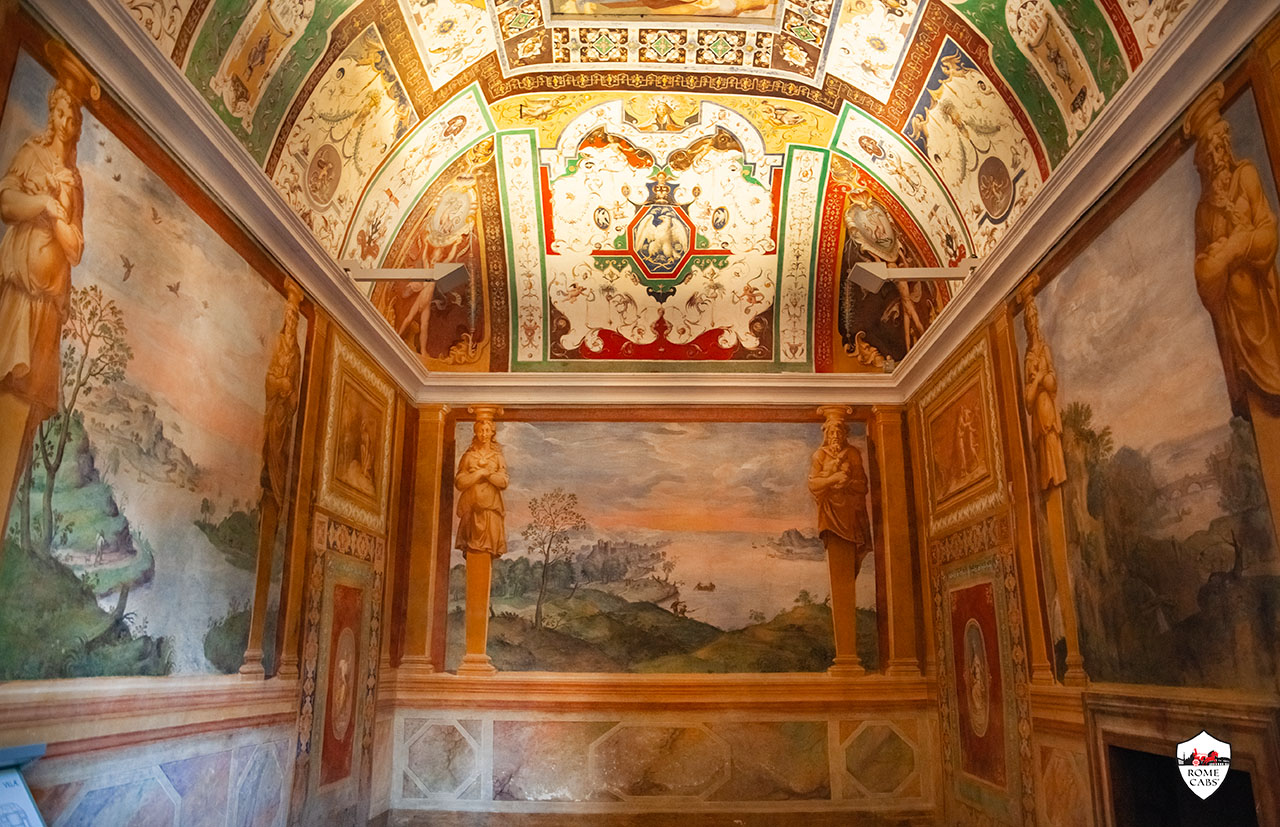
Step into the Hall of Moses, whose stories are intricately linked to the previous Room of Noah. The monochrome panels decorating the walls, illustrate Moses's journey and lead to a powerful scene on the ceiling—Moses striking a rock, a symbol echoing Cardinal Ippolito's legacy of creating magnificent fountains on the Tiburtine hills.
At the corners, a seven-headed hydra pays homage to Ercole I d’Este, vividly celebrating the esteemed member of the Este dynasty. Justice and Fortitude, embodying the virtues cherished by the Este family, gracefully joined the ethereal dance with Temperance and Prudence from the Room of Noah's ceiling.
The optical illusion, created with Doric pillars and Ionic capitals, magically expands the room's boundaries. Painted panoramic views of landscapes and water scenes are a breathtaking testament to the artistry of the 1570s.
SALON OF THE FOUNTAIN
Painted in 1565 by Girolamo Muziano and his artists
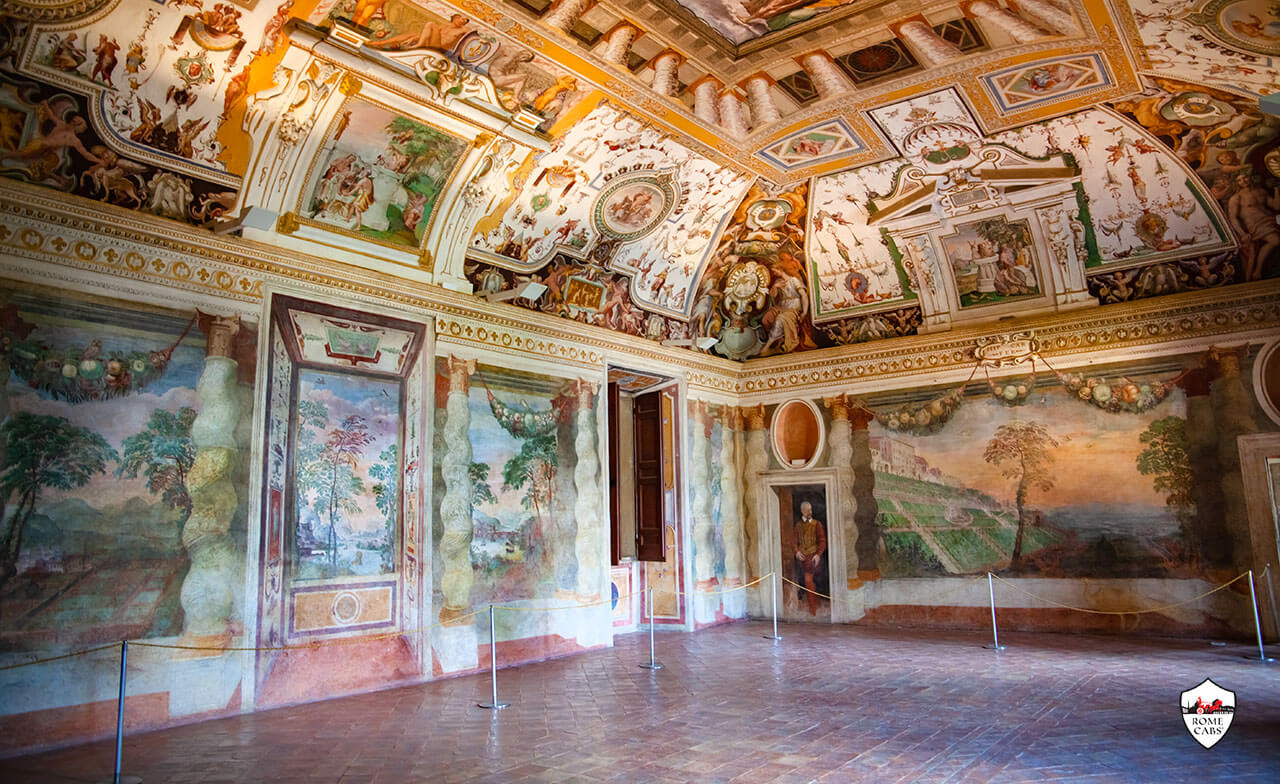
Next, step into the grandeur of the Salon of the Fountain, a hall designed for opulent banquets hosted by the cardinal. As you gaze upward towards the ceiling, the vault unveils a spectacular Feast of the Gods, inspired by Raphael's masterpiece at Villa Farnesina.
The illusionistic architecture creates an open loggia adorned with cascading garlands of fruit and flowers. Girolamo Muziano's Venetian-style panoramic scenes frescoed on the walls transport you to the Tiburtine territory, showcasing the cardinal's lavish residences. Don’t miss the wall painting of Villa d’Este based on plans from 1565.
The rustic fountain by Curzio Maccarone against the wall adds to the theatrical garden ambiance, featuring intricate mosaic and enamel pieces depicting the Temple of the Tiburtine Sibyl. Decorations of this room began in 1565, starting with this hall and extending to the adjacent Hall of Hercules.
FIRST TIBURTINE ROOM
The first and second Tiburtine Rooms were painted between 1536 and 1614 by Cesare Nebbia’s artists
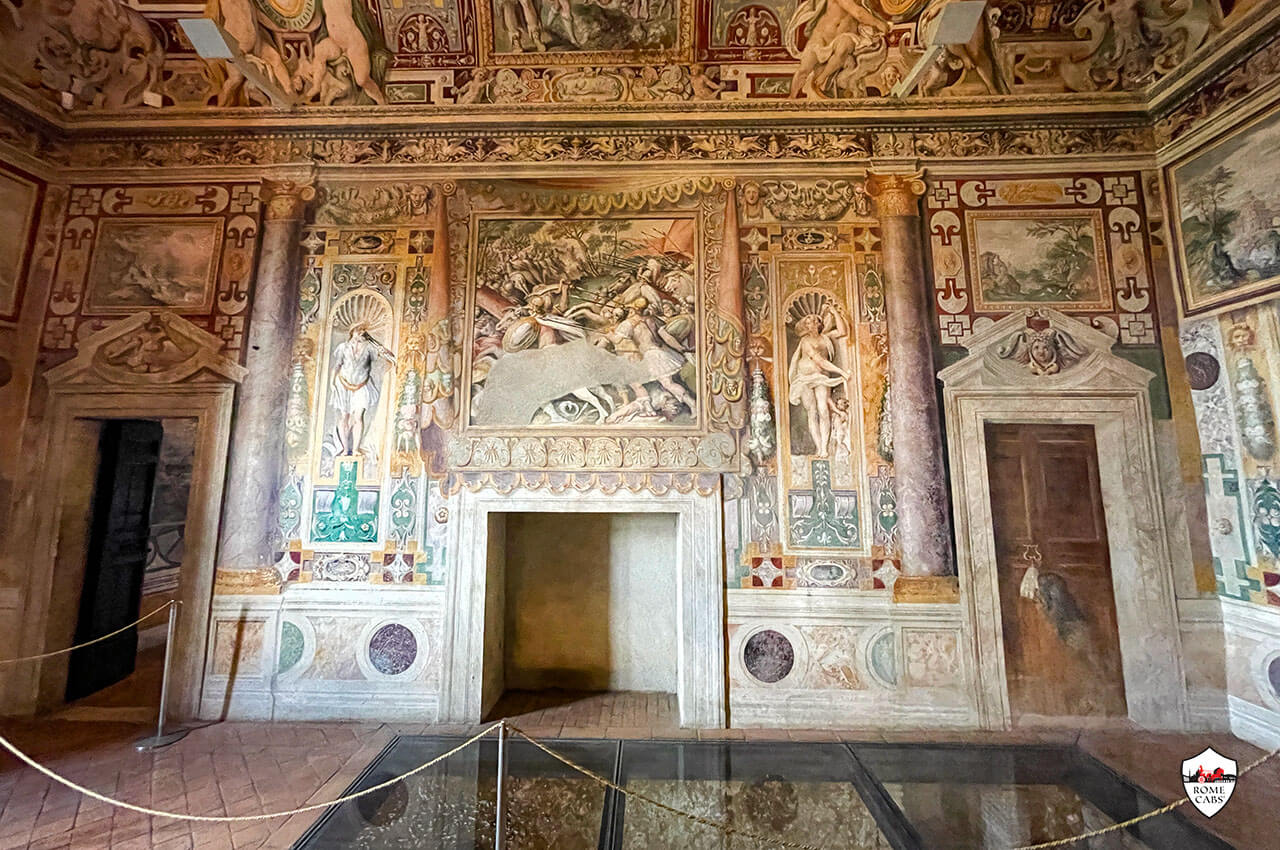
The frescoes in the First Tiburtine Room in conjunction with the next Second Tiburtine Room narrate the mythical origins of Tivoli.
As you enter the First Tiburtine Room, you'll be immersed in the timeless tale of Tivoli's mythical foundation, dating back to ancient times before Rome. The city's origins trace back to three Greek brothers—Tiburtus, Cors, and Catillus—direct descendants of the Seven Kings of ancient Thebes. Their journey brought them to Latium, where they conquered the Aniene Valley and established the city of Tibur.
In a triumphant celebration, these brothers paid homage to the gods, with special reverence bestowed upon Hercules, the mighty protector of Tivoli and a cherished symbol of the Este family. Legend tells us the city's boundaries were marked with an ox-drawn plough on April 5, 1215, BC.
In his 10th labor, Hercules daringly steals Geryon's ox, only to face a treacherous ambush by Albius and Bergius. Jupiter’s divine intervention of Jupiter came to Hercule’s rescue raining stones on his enemies, forever naming the site "Saxanus" (of the rocks).
The illusionistic architecture breathes life into Tivoli's mythic depictions—composite columns, polychrome marble, and faux tapestries that transport you to a realm where history and legend intertwine.
SECOND TIBURTINE ROOM
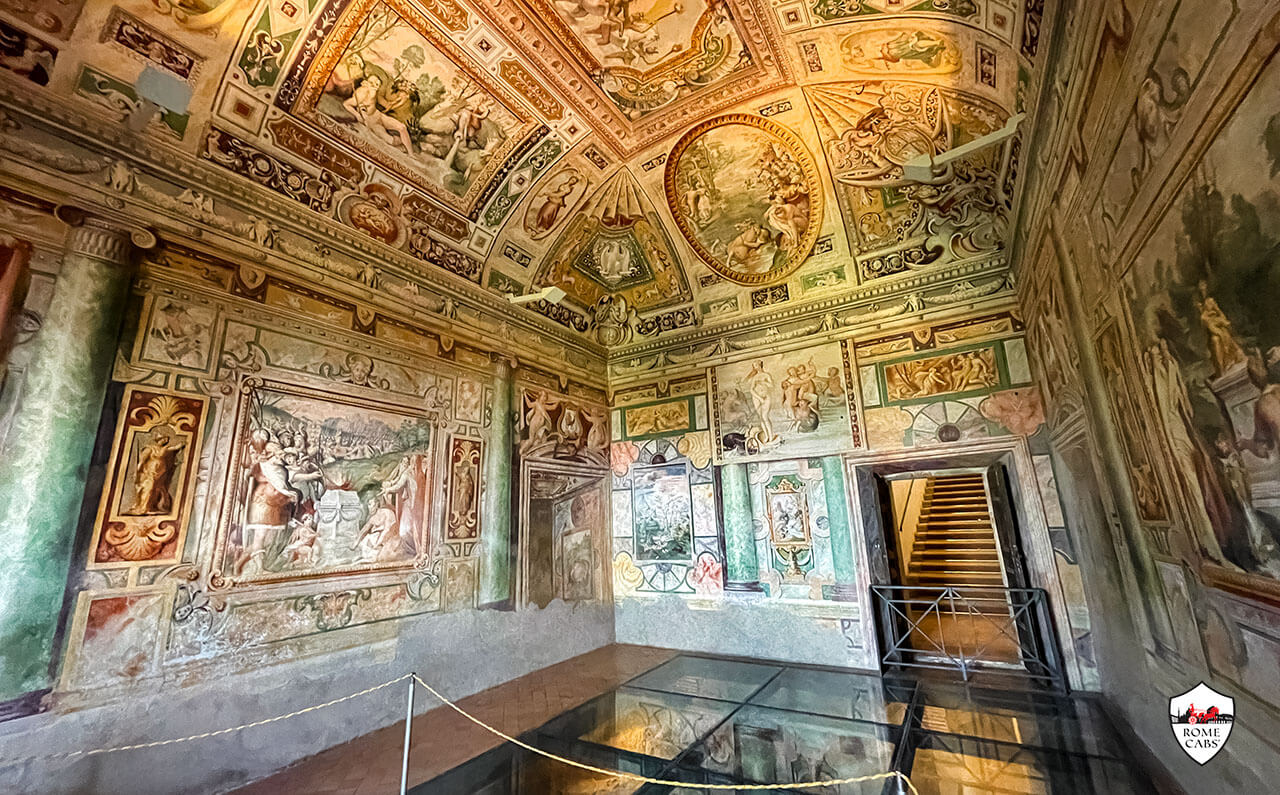
In the Second Tiburtine Room, the mythic origins of Tivoli continue. Here, the paintings focus on the metamorphosis of the Tiburtine Sibyl, or Albunea, continuing the ancient narrative from the First Tiburtine Room.
The story in this room unfolds with Ino, the wife of Athamas, nurturing Bacchus, the son of Jupiter and Semele. Jupiter's betrayal triggers Juno's fury, plunging Athamas into madness and leading to the tragic demise of his son Learchus.
Ino and her son Melicertes were saved by the divine intervention of Venus and Neptune who transformed them into marine deities Leucothea and Palaemon. Ino, now Leucothea, assumes the roles of Mater Matuta and eventually a revered Sibyl, taking residence in the mystical woods of Tivoli.
The frescoes come to life with illusionistic architecture vaunting intricate details of composite columns, faux marble, painted tapestries, and whimsical grotesques, transporting you into the magical world of myth and legend.
HALL OF HERCULES
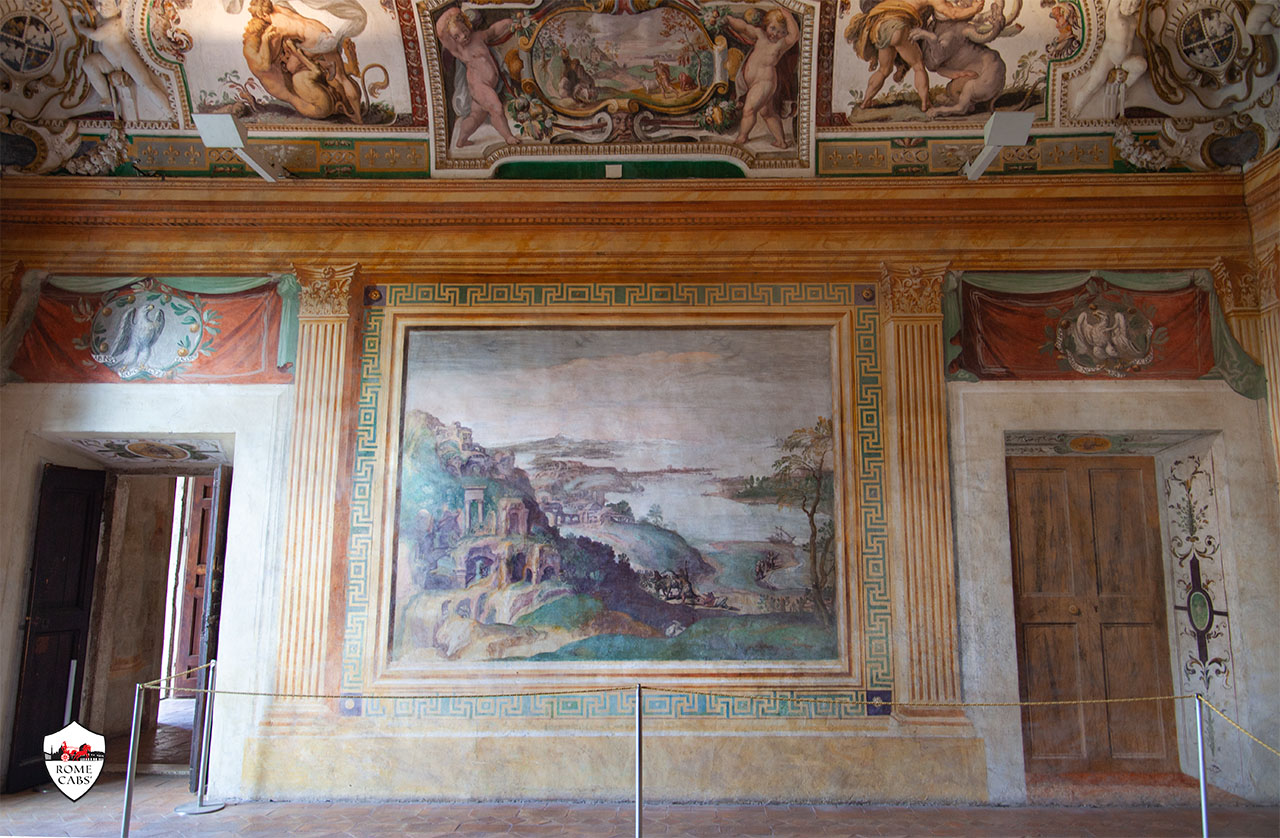
The captivating Hall of Hercules pays homage to the legendary hero intertwined with the mythical origins of Tivoli and the Este family. Corinthian pilasters frame both tangible and illusory doorways and windows, creating an elegant dance between reality and imagination.
Girolamo Muziano's masterful landscape scenes with ancient ruins adorn the walls. Look up, and the vaulted ceiling unveils a visual symphony narrating Hercules' life, drawing inspiration from Giovanni Boccaccio's Genealogy of the Gods.
At the heart of this room lies the essence of Hercules' legends, intertwined with Villa d’Este's symbolic iconological design. The Cardinal's coat of arms in stucco are supported by winged cupids, and framed by the Four Cardinal Virtues. The mythical Garden of Hesperides and its golden apples serve as a powerful symbol of eternity and a representation of the everlasting nature of Hercules' heroic feats.
The central ceiling fresco portrays Hercules conquering his 12 Labors, and being welcomed among the Gods of Olympus. Catch a glimpse of the hero from behind, leaning on his club, the Nemean Lion's skin on his back.
HALL OF NOBILITY
The frescoes were created between 1566-67 by Federico Zuccari and his assistants
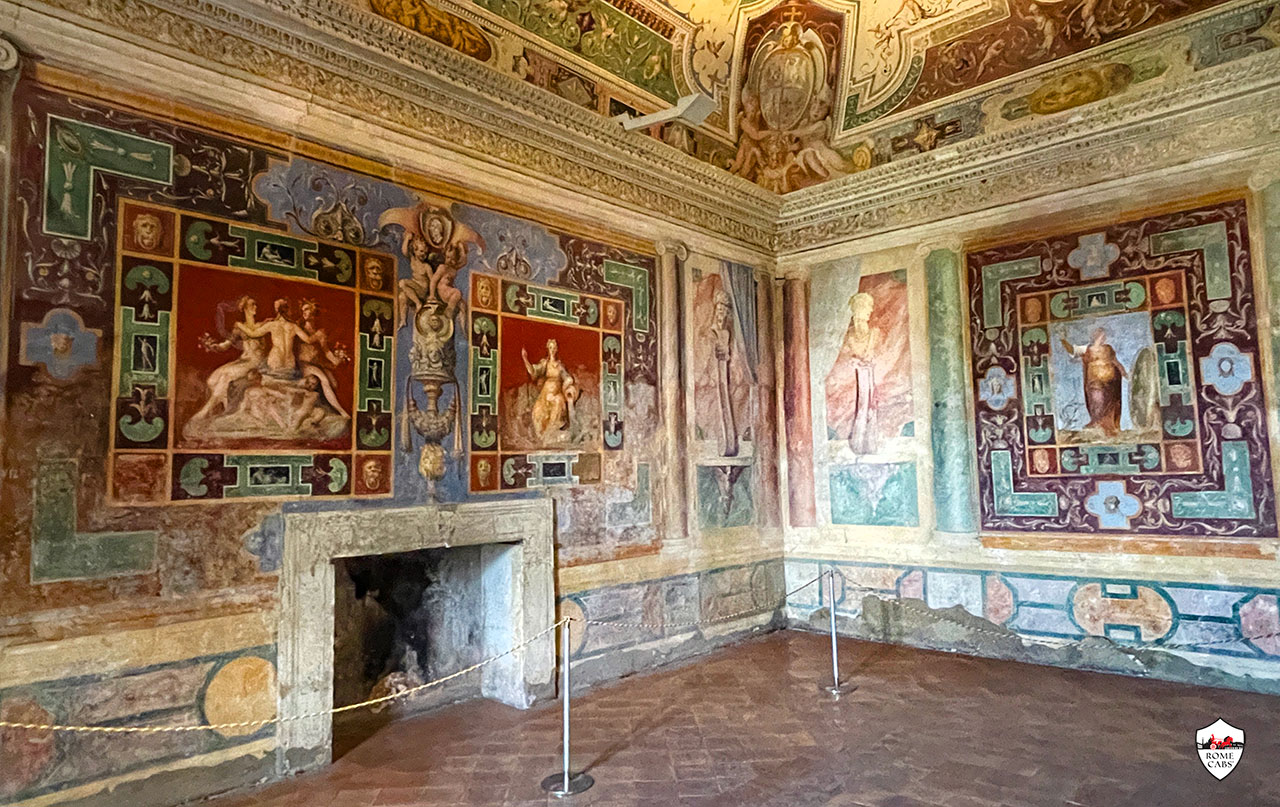
Hall of Nobility was designed to allegorically honor the moral virtues embodied by the House of Este and Cardinal Ippolito. Captivating illusionistic architectural elements that adorn the walls, such as Ionic columns, polychrome marble, and vibrant "Pompeian Red" backgrounds that elegantly frame allegorical depictions of Virtues and Liberal Arts. Ancient philosophers and lawmakers are represented in a series of busts
Gaze up to the vault's center where the personification of Nobility reigns surrounded by her handmaidens Liberality and Generosity, all set in a captivating "grotesque" ambiance.
In each corner, Cardinal Ippolito's coat of arms is displayed featuring a white eagle, branches of golden apples, and the poignant motto "Ab Insomni non custodita dracone" (Not guarded by the sleepless dragon), a powerful reference to the 11th labor of Hercules.
HALL OF GLORY
The paintings were created between 1566-68 by Federico Zuccari and his assistants
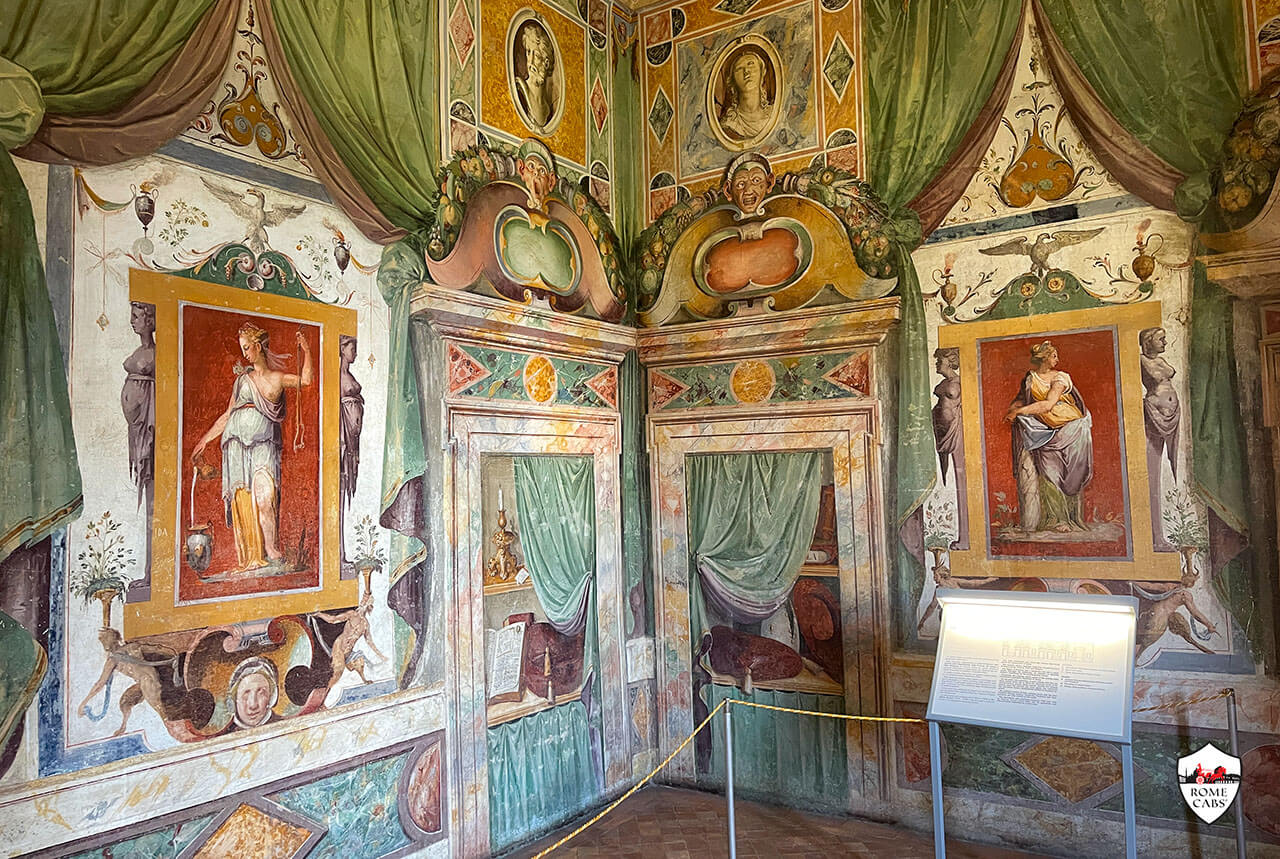
Enter the Hall of Glory, where virtues pave the path to achievement, and the vaulted ceiling is adorned with allegorical figures embodying Magnanimity, Fortune, Time, and Religion. Fortune, adorned with a cardinal’s hat and papal crown, subtly alludes to Ippolito d’Este’s ecclesiastical aspirations. Notably, the absent center panel symbolically represents Glory itself.
Two paintings of open closets on the walls are reminiscent of 15th-century private study spaces showcasing various objects, including the cardinal’s hat and papal crown, offering glimpses into Cardinal Ippolito d'Este's world. Enhancing the room's ambiance, six panels display faux antique busts and illustrate the Four Cardinal Virtues—Justice, Fortitude, Prudence, and Temperance.
HALL OF THE HUNT
The paintings were created in 1614 by Giovanni Ferri and Rinaldo Lombardo, inspired by the engravings of Antoni Tempesta
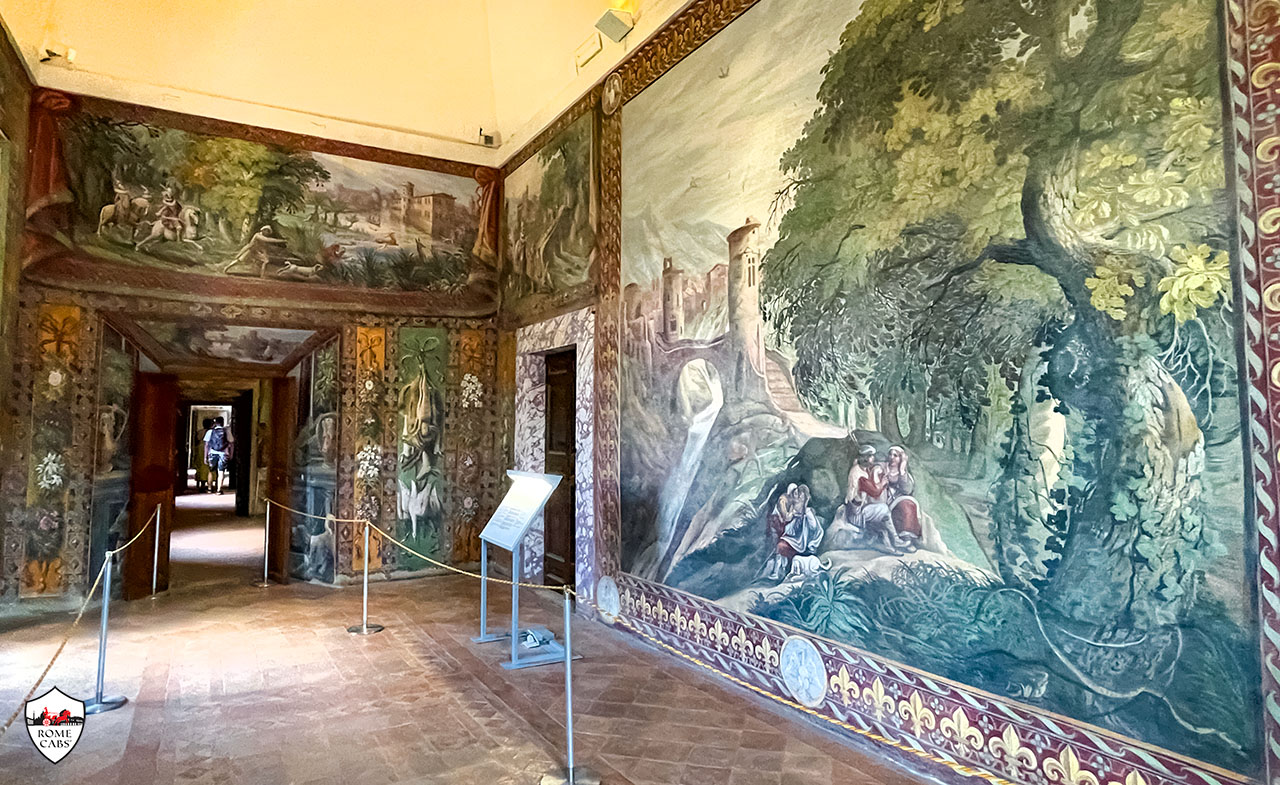
Step into the Hall of the Hunt, a room named after its painted frescoes of hunting scenes on both land and water. The four walls are richly adorned with two large painted panels, Trompe l’oeil tapestries, hunting trophies, and delicate floral garlands.
As you gaze along the detailed wall paintings, notice the smaller landscapes filling door and window recesses, offering glimpses of aristocratic deer hunts with dogs in a river. The thematic series is complete with naval battles, shipwrecks, and a scene depicting a blaze, symbolizing the four elements: Air, Water, Earth, and Fire.
Exit to Villa to The Vialeone (the Great Terrace)
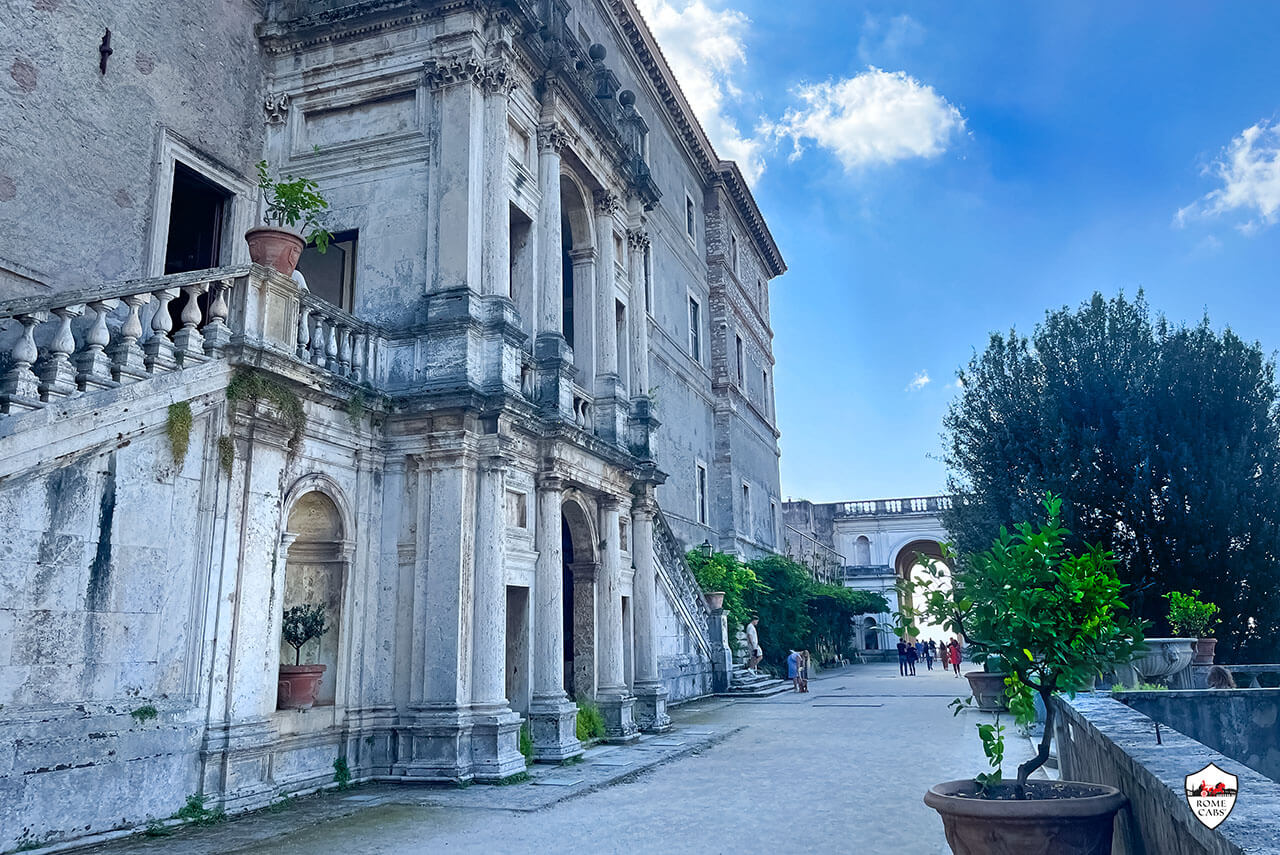
As you leave the Villa to explore the gardens, you pass through a covered loggia and descend Pirro Ligorio's impressive double staircase, leading you to the extensive terrace named Vialone.
Stretching 200 meters between the Villa and the gardens, the Vialone offers visitors an expansive panoramic view of the gardens and the surrounding countryside. Initially shaded by two rows of elm trees, this terrace served both as a cool retreat in the summer and a strategic vantage point to enjoy the scenic beauty. The Cardinal utilized this space for entertaining, games, and festivities.
Adjoining the villa's facade in the terrace's center is the double loggia, constructed between 1566 and 1577 using travertine stone. The loggia features two staircases providing access to the ceremonial salons on the lower floor, while its upper level serves as a terrace connected to the Cardinal's apartments.
From here you may proceed with a scenic stroll through the immaculate Italian Renaissance gardens, where a multitude of fountains orchestrates a harmonious symphony.
